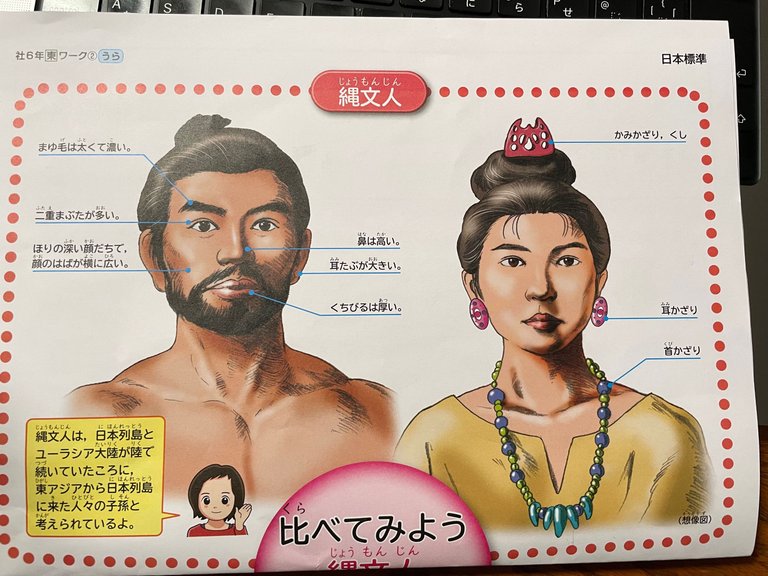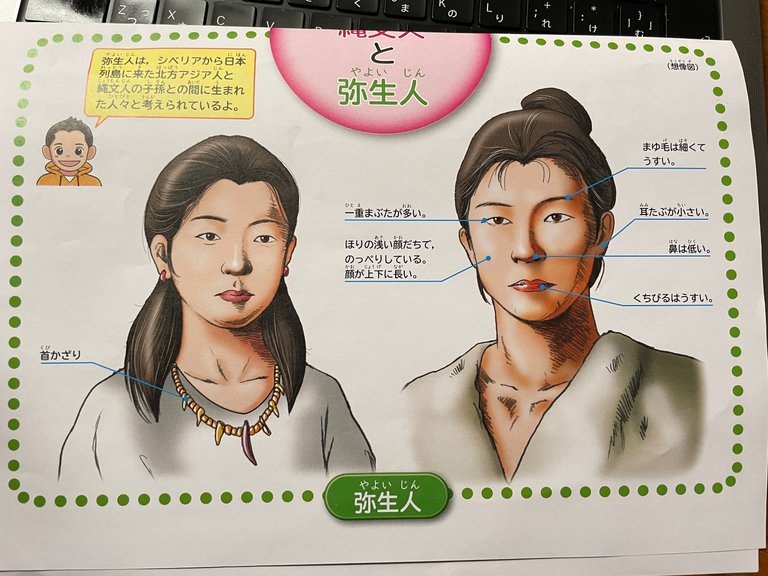Some time ago I wrote a post about two early Japanese tribes that came to the country at two different times, how these two groups are more or less considered the ancestors of modern Japanese, and how even today we sometimes use these two groups to classify people based on their facial features.
If you missed that first post, see: What Kind of Face Do You Have.
A few days ago my son brought home a worksheet from school that reminded me of this. Here it is.


Let me break it down for you. The first side (well, top half; it's an A3 sheet of paper) shows Jomon people, and the second side shows Yayoi people.
The two sides basically point out some facial features on the men and the necklace/earrings/hair piece on the women.
Of the Jomon features, it tells us:
- The eyebrows are thick and dark
- Many have double-eyelids
- The face is deep, chiseled features, and a broad, horizontal shape
- The nose is high
- The ears have large earlobes
- The lips are thick
(By the way, is it just me or does that Jomon guy look like Toshiro Mifune?)
Of the Yayoi, it tells us:
- The eyebrows are fine and thin
- Many have single-eyelids
- The face is long
- The ears have small earlobes
- The lips are thin
A basic translation of the two descriptions is something like:
The Jomon are thought to be descendants of people who came to the Japanese archipelago from East Asia when Japan and Eurasia were connected by land.
This would have been between 14000 and 300 BCE, during an ice age when the oceans were more shallow.
The Yayoi people are thought to have been born between Northern Asians who came to Japan from Siberia and the descendants of the Jomon people.
The Jomon description is fairly accurate I think, but the Yayoi is a little simplified and confuses some things. It is written for eleven-year-olds so we can forgive them for not being exact.
The Yayoi are thought to have come from Korea, not Siberia. The Korean Peninsula itself is a mixture of groups. The reference to Siberia likely addresses the broader ancestral origins that include traits adapted from colder climates, the most easily seen being the epicanthic fold (i.e. the single-eyelid), itself likely an adaption to combat snow blindness, which are prevalent in northern Asian populations.
Anyway, the Jomon are thought to have been hunter-gathers while the Yayoi brought wet-rice agriculture from Korea as well as new tools that allowed them to more or less conquer the Jomon.

Interesting, huh? heh as my son's school gets more into history, I may be more interested in the worksheets he brings home than he is.
❦
 |
David LaSpina is an American photographer and translator lost in Japan, trying to capture the beauty of this country one photo at a time and searching for the perfect haiku. He blogs here and at laspina.org. Write him on Twitter or Mastodon. |